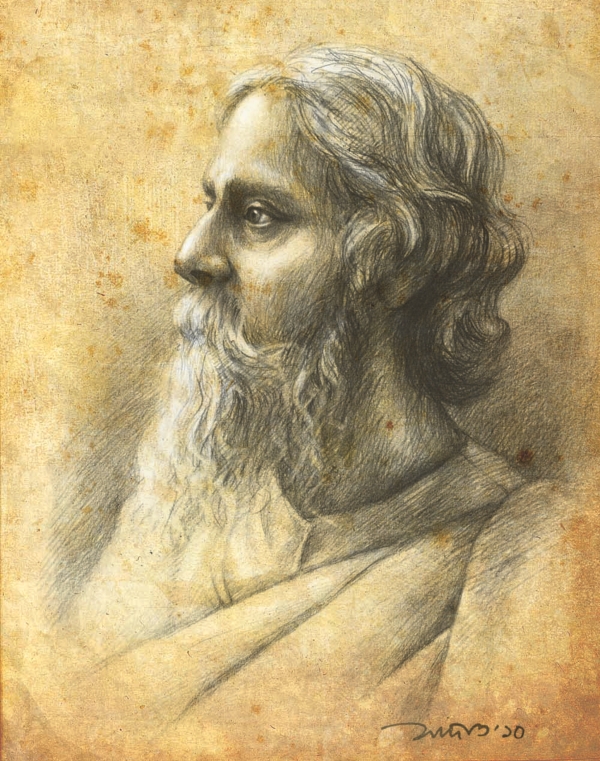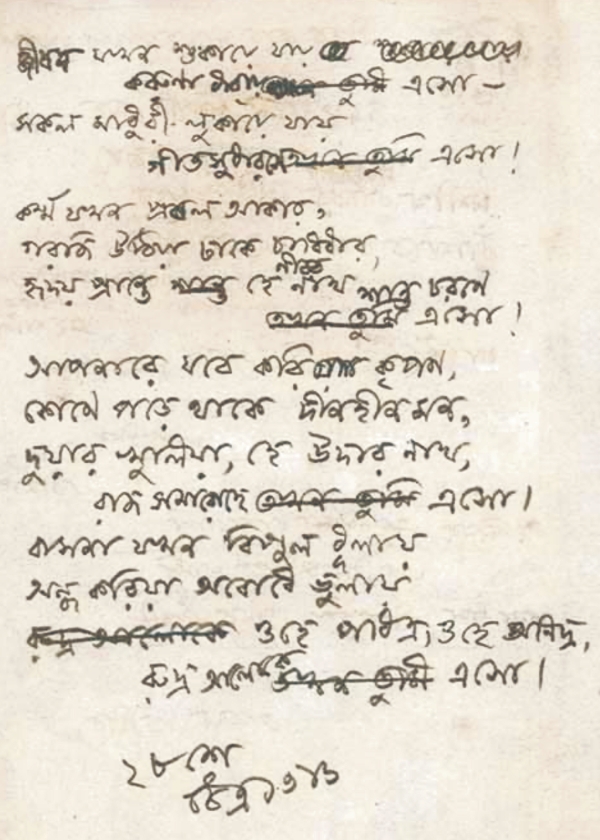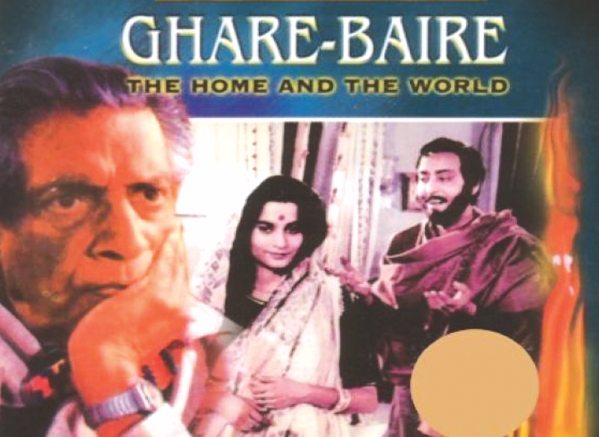
Inside
|
Tagore on Film
As Tagore's 150th birthday is being celebrated throughout the year, TRISHA GUPTA pays tribute to the legendary poet.

The reputation Rabindranath Tagore enjoys as a literary figure in India has never been in any doubt. He towers over the national imagination as the exemplary man of letters, whose astounding versatility as a writer encompassed everything from short stories, novels and plays to poems, songs and essays. And yet, while his stories, plays and poems are enshrined in syllabi, performed in colleges and sung every day by thousands of people in West Bengal and Bangladesh, it has always been somewhat difficult for those who do not speak or read Bengali to fully appreciate his genius. As several commentators have noted, Tagore suffers greatly in English translation. Many of these translations are, of course, Tagore's own. But Tagore himself was long unsure of his these texts: “I am sure you remember with what reluctant hesitation I gave up to your hand my manuscript of Gitanjali, feeling sure that my English was of that amorphous kind for whose syntax a schoolboy could be reprimanded,” he wrote to his friend William Rothenstein, an artist who first sent the Gitanjali poems to the poet WB Yeats. Even Yeats, who worked with Tagore on the English version of Gitanjali and was at least partly responsible for the initial rave reviews that Tagore got in the West (leading to the Nobel Prize in 1913 and a knighthood in 1915, which he later returned in protest against the Jallianwalla Bagh atrocities), later made public his distaste for Tagore's translations of his own work. “Tagore does not know English, no Indian knows English,” Amartya Sen cites him as having written. Even if one leaves aside Yeats' somewhat extreme positions, it is undeniable that most English translations of Tagore have had a florid, often overwrought quality that doesn't merely camouflage the power and beauty of Tagore as a literary stylist, but actually turns the modern reader away from him.
While the task of the translator remains crucial (and some of the newer English translations may well achieve what previous efforts have not), one rather pleasurable way in which the non-Bangla reader may enter the world of Tagore is by circumventing the literary route altogether -- in favour of a cinematic one. Over a hundred filmic adaptations of Tagore's work have been made over the years, and watching the best of these films -- for example, Tapan Sinha's Khudito Pashan (Hungry Stones, 1960) and Kabuliwala (1957), remade in Hindi by Hemen Gupta in 1961, or Satyajit Ray's Teen Kanya (Three Daughters, 1961 a triptych based on three short stories: Postmaster, Monihara, and Samapti), Charulata (The Lonely Wife, 1964) and Ghare Baire (The Home and the World, 1984), or Kumar Shahani's interpretation of Char Adhyay (1997) helps bring to the fore several of Tagore's lifelong concerns: his profound engagement with the condition of women, especially within the context of the upper caste Hindu family; his complicated relationship with nationalism and with modern politics in general; and his attempt to grapple with the colonial condition, with the relationship between India and the West, tradition and modernity.
In film after film, we see events through the eyes of the educated Bengali man trying to deal with a world that has either changed too much -- or too little. The protagonist is often a young man from the city who arrives in a small provincial outpost, armed with a modern Western education and little else, his head full of glimpses of another world that seem only to succeed in cutting him off from everything around him. Think of Soumitro Chatterjee as the personable young revenue collector who goes to work for the Nizam's government in Khudito Pashan, ostensibly too rational to listen to the locals who urge him not to stay in the haunted palace. Or of the amiable (if faintly ridiculous) Anil Chatterjee in The Postmaster, who talks of writing poetry and refuses an invitation to the local gaaner ashor (musical evening) because he's “just started on a work by Scott”. Or Soumitro again as the would-be lawyer in Samapti, returning to his mother's village home with the barely disguised impatience of the urbane, reading a copy of Tennyson's poems on the boat.
These are characters under the mythic spell of what they understand as Western civilisation. It was a feeling that Tagore knew all too well: “Before I came to England,” (he wrote in 1878),

“I supposed it was a small island and its inhabitants were so devoted to higher culture that from one end to the other it would resound with the strains of Tennyson's lyre.”
But while he sees the incongruity of these characters, and is able to laugh at the absurdity of their attempts to distinguish themselves from the supposedly uneducated masses -- the postmaster attempts to sit and read his Walter Scott on a chair, but it collapses under him and he is forced to crouch on the mud floor, under the gaze of the village madman, the would-be lawyer with his highly polished shoes refuses to heed the boat-boy's warning and falls headlong into the mud Tagore never fails to take seriously the fact that these are men who are striving to be modern, to break from the past.
And the objects of their desire for change, most often, are women.
So in Samapti, Soumitro's character agrees to oblige his mother by marrying, but he rejects the 'suitable girl' his mother has chosen for him, the girl who can cook and sew and sing and will never answer back. Instead he picks the village tomboy, Mrinmoyee (memorably played by the astoundingly young Aparna Sen, then Dasgupta), who spends her days climbing trees with the local children and is generally so unsocialised into proper femininity that she is referred to as Pagli (madcap). But the radical thing here is not only that he chooses the “unfeminine” girl, but that he then has to deal with the fact that she has not chosen to marry him. He must wait, then for her consent. In a different but related register is Nondo the postmaster's attempt to educate the village waif who works for him. Ratan, as the girl is called, is a willing and able student, and a gentle camaraderie springs up between her and Nondo, so much so that when he decides to leave the village, she feels profoundly betrayed. In Tagore's story, Ratan's response is to ask Nondo whether he will take her with him. When he laughs her off, she refuses his pity and his gift of money, in a flood of tears. In Ray's film, Ratan acquires an even stronger sense of self: she never asks to be taken along, and her response is not to show her grief, but to hide it.
The education of women into selfhood, the possibility of their being independent, self-determining individuals, also lies at the core of Ghare Baire (The Home and the World). Here it is Nikhil, the educated sensitive zamindar played by Victor Banerjee, who seeks to equip his wife Bimala (Swatilekha Chattopadhyay) with an education. More than the piano lessons, Western-influenced fashion and English etiquette, however, what he wants is for his wife to step out of purdah, form her own opinions freely on every subject, including, most radically, on whether she really loves him.
The companionate marriage was something that Tagore seems to have striven for and never quite achieved -- in his own life. Even during his short-lived marriage, from 1883 until his wife Mrinalini's death from illness in 1902, the kind of relationship he dreamt of eluded him. “If you and I could be comrades in all our work and in all our thoughts it would be splendid, but we cannot attain all that we desire,” he once wrote in a letter to her. If the fictional Bimala is a complex articulation of Tagore's wifely dreams, the cold, uncaring wife in Monihara, whose husband ceaselessly gifts her jewellery on the plaintive condition that in return she should “love him a little”, is her nightmarish doppelganger. The link between these two, of course, is Ray's magisterial Charulata, based on Tagore's short story 'Noshto Neer' (The Broken Nest), about a woman who is neglected by her much older husband and forms a half-filial, half-romantic attachment to her young brother-in-law: the kind of bond that, in Amit Chaudhuri's words, “almost thrives on the permanent impossibility of consummation”. Again, the autobiographical element cannot be ignored: Tagore is known to have been very close to his elder brother's literature-loving wife, Kadambari, dedicating several of his early poems to her. Tragically, she committed suicide four months after Tagore's wedding for reasons that are not entirely clear.
The other way in which women figure in Tagore's world is as the (often unwilling) objects of idealisation by men. The gentlest version of this in this collection is to be found in Kabuliwala, where the superb Balraj Sahni plays a burly Afghan trader who makes a little Bengali girl called Mini the object of his fatherly affections, imagining in her a replacement for the daughter he has left behind in Afghanistan. In Ghare Baire and Char Adhyay, the idealisation of the feminine is carried out under the auspices of nationalism, with the primary motif being Bharat Mata, the nation as mother but nationalist discourse does not allow women to speak, they are merely a sign within it. Sandip, the fiery Swadeshi leader in Ghare Baire, wants to anoint Bimala as the movement's mascot, talking all the while of women's native “intuition” as superior to men's educated ideas, but never tells her what his political activities actually consist of. Char Adhyay takes the inhumanity and hypocrisy of this symbolic adoration to its logical end, with the hapless Ela unable to escape the chains of idealisation that bind her to the armed nationalist group of which she is the mascot.

Both these films also give one a glimpse into Tagore's deep ambivalence towards what the political theorist Sudipta Kaviraj has spoken of as “the morally destructive effects of political enthusiasm”: not just the likelihood of a drift towards violence, but also the modern mass movement's inherent tendency to substitute arguments with slogans, the inevitable stifling of internal moral diversity. Tagore started out as a supporter of the nationalist movement, but gradually came to see it as the necessary submergence of one's individuality in a collective flood of feeling, something of which he could not approve. As the thoughtful zamindar Nikhil says to his mocking nationalist friend Sandip in justification for his anti-Swadeshi stance, “Ami kono nesha-i kori na”, meaning “I consume no intoxicants”.
As a novel, Ghare Baire is perhaps the most remarkably fleshed-out articulation of Tagore's worldview. And Ray's filmic interpretation of it is astute, even if the structure of cinema (and of our expectations as viewers) makes it less open-ended than fiction has the privilege of being -- for example with regard to the question of whether Nikhil is mortally wounded in the end.
The open-ended-ness of Tagore's vision is largely lost in Tapan Sinha's version of Khudito Pashan, too. A wonderful English translation of this classic ghost story is available in Amitav Ghosh's The Imam and the Indian, 2002), and it is fascinating to set it alongside the film and see what gets excised and what altered. The original is a tale within a tale, a story told by a man that the narrator and his cousin meet on a train on their “way back to Calcutta after a trip around the country during the Puja holidays”, and his narration is broken off before the tale comes to an end, leaving the reader with no clear answers and much room for imagination.
But cinema, as we know, provides other pleasures than fiction. While Tagore's original text of Khudito Pashan had only words with which to conjure up its deserted pavilions echoing with long -ago music, Tapan Sinha's film can contain a background score by Ustad Ali Akbar Khan which is haunting in every sense of the word. Kumar Shahani's highly experimental interpretation of Char Adhyay, with its deliberately stagey, ostensibly 'poetic' dialogue (“Baat koi yah bhi?” or “Jaanti thhhi kaise main, de doge sab kucch?”) may not be everyone's cup of tea, but there is no doubt that it creates a world astonishingly lovely to look at, filled with stunning, sometimes surreal, imagery: waterlilies reflected in pools, a stream turning crimson with blood, white-khadi-clad women swinging in forested glades, a beach covered with red crabs. In the poetry of images, there can be no better tribute to Tagore.
Trisha Gupta is a writer who lives in Delhi. Her published work is archived at her blog Chhotahazri <trishagupta.blogspot.com>.